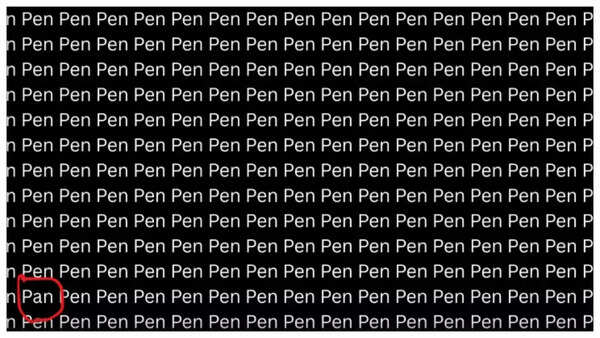Optical illusions are captivating the internet, offering a stimulating brain workout and a fun way to test your observational skills. These visual puzzles provide a delightful distraction, turning an ordinary evening into an engaging experience. An optical illusion arises when our brain misinterprets the information our eyes perceive. This happens when the data received by the eyes clashes with the brain's processing, leading to a distorted understanding of what we see. These illusions often trick us into perceiving nonexistent elements or interpreting objects differently from reality. For instance, a static image might appear to be moving, or two identical shapes might seem to differ in size.
Can you identify the odd word?
The image presents the word "pens" repeated numerous times. The stark contrast of white text against a black background makes the words visually prominent. However, there's a hidden challenge. Among the sea of "pens," there's a single, different word. Finding it requires a sharp eye and focused attention. If you look closely enough, you may be able to identify it within 10 seconds. Are you ready? Start the clock.
Giving up already? The word you're looking for is "pan." The similar spelling makes it deceptively difficult to spot. The answer is highlighted below for your convenience. Did you find it yourself? Let us know in the comments!

There are primarily three categories of optical illusions:
Literal Illusions: These illusions occur when the brain pieces together various elements of an image, ultimately creating something that does not actually exist. A classic example is an image that can be perceived as either two faces or a vase, depending on the viewer's interpretation.
Physiological Illusions: These illusions stem from the overstimulation of our visual system. Excessive exposure to light, movement, or color can cause effects like afterimages or the illusion of motion in static images.
Cognitive Illusions: These illusions hinge on the brain's subconscious interpretation of visual information. A well-known example is the Müller-Lyer illusion, where lines appear to be of different lengths based on the shapes surrounding them.
Newer articles
Older articles
 Kavya Maran on IPL Fame, Team Passion, and Viral Meme Status
Kavya Maran on IPL Fame, Team Passion, and Viral Meme Status
 Rishabh Pant's 'Revolutionary' Batting Redefining Cricket, Says Greg Chappell
Rishabh Pant's 'Revolutionary' Batting Redefining Cricket, Says Greg Chappell
 Raducanu Quashes Alcaraz Romance Rumors, Confirms US Open Doubles Partnership
Raducanu Quashes Alcaraz Romance Rumors, Confirms US Open Doubles Partnership
 FIFA Club World Cup 2025: Upsets, Messi Magic, and 2026 World Cup Concerns Emerge From Group Stage
FIFA Club World Cup 2025: Upsets, Messi Magic, and 2026 World Cup Concerns Emerge From Group Stage
 Rohit Sharma Reflects on India's T20 World Cup Win, Hails Barbados as Key to Victory
Rohit Sharma Reflects on India's T20 World Cup Win, Hails Barbados as Key to Victory
 Warning Signs: 5 Subtle Symptoms of Prediabetes You Shouldn't Ignore
Warning Signs: 5 Subtle Symptoms of Prediabetes You Shouldn't Ignore
 Wimbledon 2025: Dates, Prize Money, and Streaming Guide for Fans in India & US
Wimbledon 2025: Dates, Prize Money, and Streaming Guide for Fans in India & US
 Gavaskar Calls for Kuldeep Yadav's Inclusion in Second Test Amid Bumrah Fitness Concerns
Gavaskar Calls for Kuldeep Yadav's Inclusion in Second Test Amid Bumrah Fitness Concerns
 Former India Selector Slams Fielding Blunders After Test Defeat to England
Former India Selector Slams Fielding Blunders After Test Defeat to England
 Former Pakistan Player Kamran Akmal Blasts PCB Over Azhar Mahmood Test Coach Appointment
Former Pakistan Player Kamran Akmal Blasts PCB Over Azhar Mahmood Test Coach Appointment